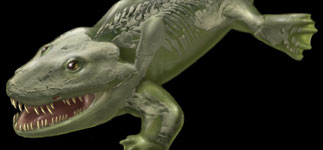Redesigning tetrapods - Planet Earth
Interview with
360 million years ago, the first four legged creatures started moving from the water onto land. But what did our (very) distant ancestors look like?
Early research suggested they were something like a salamander. But new studies of the fossils, carried out by Jenny Clack from the University of Cambridge and Stephanie Pierce from the UK's Royal Veterinary College, has found that these 'tetrapods' were nothing like the pictures in textbooks.
Planet Earth Podcast presenter, Richard Hollingham, went to see one of the fossils and talk to Jenny and Stephanie at the Zoological Museum in Cambridge. He started by asking Jenny about the assumptions they were challenging...
Jennifer Clack: The first creatures to emerge from the water and start to evolve legs with fingers and toes, people assumed that these would have had legs with weightbearing limbs and that they would have walked in the same way that modern four limbed creatures walk, like a lizard perhaps or a salamander, and they envisaged these early tetrapods, as we call them, as giant salamander-like creatures and that's how they were first reconstructed.
Richard Hollingham: So, Stephanie, what did you do? What did you do to these fossils to find out what they were really like?

Stephanie Pierce: Well over the last three or four years what we've been doing is we've been looking at the fossils that are still embedded inside the rock, so the fossils that we can't see on the outside and to do this we've been using modern technologies, we've been using micro CT scanners and when we looked at the vertebral column the bones of the vertebrae that were still trapped inside the rock we weren't able to identify all the different parts that were supposed to be there based on what had been described in the literature and in text books over about the last 100 years and so this got us really, really puzzled. What was actually going on in the backbone of this animal? And what we decided to do was take it to the European Synchrotron Radiation Facility and create UB high resolution images using synchrotron x-rays and what we found was something very, very interesting.
Richard Hollingham: So you've got a representation of this; what you saw inside this fossil on the computer screen in front of us and it's a three dimensional representation and this wasn't what you expected.
Stephanie Pierce: It's not quite what we were expecting. When you talk about modern tetrapod backbone their vertebrae are composed of individual units that are all interconnected and those units are composed of only one bone. An early tetrapod vertebral column is actually slightly different. It's actually composed of many different bones and in particular each unit is supposed to be composed of three separate bones, it is supposed to be composed of one bone in the front, which is called the intra centrum and that's the green bone in the image here. One bone on the top which is called the neural spine and that's the pink bone in the image and then a pair of little bones at the back called the pleura centra which are the yellow bones in this image. But that sort of concept of what an early tetrapod vertebrae looked like isn't actually what we found when we did the synchrotron scanning of this fossil.
Richard Hollingham: So what did you find? What was different about it?
Stephanie Pierce: Well, some of the bones ended up being fused together and in particular the bone at the front, the intra centrum, was actually fused onto the back of the pleura centra and this was very unusual because that indicated to us that the first bone in the series, the intra centrum, was actually in fact the last bone in the series and this meant that all the literature in the text books previously actually had the backbone back to front in these animals.
Richard Hollingham: What does this actually tell you about the animal - what it looked like and maybe how it moved?
Jennifer Clack: One of the things that we found you can see represented by a series of blue elements and the nearest equivalent we can find in modern animals is the sternum, the breastbone, and that corresponds to the idea that these creatures were not walking with alternating footprints as you would expect but actually were using a kind of crutching motion. So using their front legs to, kind of, hop forwards and then pushing or stabilising with the back legs because the back legs were paddle shaped, they weren't walking legs, they didn't have proper knees or ankles, they were stiff and probably were just sitting there in the mud and used for swimming in the water but as stabilisers and anchors on land.
Richard Hollingham: So based on this study what do you now know that they look like?
Jennifer Clack: It's shoulders were relatively enormous and it had this big rib cage which then faded out into a rather weak bit of backbone just before where the hind legs fit in, and the hind legs were paddles set sort of vertically against the body and a little short stubby tail, a big head, big shoulders and rather diminutive hind quarters.
- Previous Curious About Comets
- Next Subterranean hearing










Comments
Add a comment